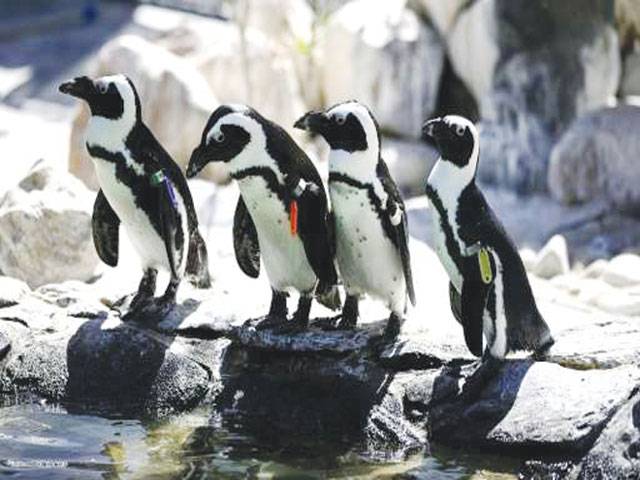AFP
CAPE TOWN
In the cold, clear waters at Boulders Beach in Cape Town, the African penguins are so relaxed they swim among humans and waddle past sunbathers on the sands.
But their unique species is dying, and scientists are trying to solve the mystery of whether it is humans that are killing them, and if so, how. As representatives from over 150 countries huddle at a Paris conference aimed at achieving a global agreement on fighting climate change, the scientific sleuthing off Africa’s southwestern coast highlights the difficulties in pinning down the links between global warming and animal behaviour.
African penguins are found only in South Africa and neighbouring Namibia, where they feed on fish shoals in the nutrient-rich waters of the cold Benguela current that runs northward along the west coast. The number of breeding pairs has dropped by 90 percent at South African colonies north of Cape Town, from about 32,000 in 2004 to just over 3,000 in 2014, according to official statistics.
There is little dispute that the reason for the sharp decline in the number of little jackass penguins - so nicknamed for their braying calls - is the strange behaviour of their main prey, sardines and anchovies. The concentrations of fish have moved southwards and eastwards, leaving the penguins dying of hunger in their wake.
Scientists say an obvious culprit might appear to be overfishing, but there is some dispute about whether this is borne out by the results of periodic fishing bans around some of the penguins’ major habitats. “The fish have seemingly changed their distribution, but what caused that is still a big research question,” said Rob Crawford, a scientist with South Africa’s department of environmental affairs.
“Overfishing and climate change are the main two possibilities and it is very hard to disentangle them,” he told AFP. There is no question that humans were responsible for an initial steep decline in the number of African penguins, which are classified as endangered by the International Union for the Conservation of Nature.
The environmental affairs department says the overall South African population may have been around a million breeding pairs in the 1920s - dropping to just 19,000 in 2012. The exploitation of eggs for human consumption played a major role in the early disastrous decline, but egg collection was banned in 1967 and numbers have continued to plummet.
The population in Namibia has also fallen sharply, from 12,162 breeding pairs in 1978 to an estimated 4,563 pairs in 2008, according to Birdlife International. “There is no clear cut answer that climate change (over long-term environmental variation) is a driver, but it is thought to be playing an important role,” says Richard Sherley, a University of Exeter researcher and expert on the African penguin.
“Changes in sea surface temperatures in the 1990s and early 2000s have resulted in (amongst other things) a change in the area most suitable for spawning for anchovy and sardine,” he told AFP in an email interview.
“As a result, the high-energy prey that the adults of these fish species represent for penguins is far from the penguin colonies on South Africa’s West Coast for much of the year.” A plan to establish a new colony for penguins on the south coast, closer to their shifting food source, is among proposals aimed at saving the species.
Wednesday, April 17, 2024
Imperilled African penguins pose scientific mystery

3:56 PM | March 28, 2024
4:14 PM | March 23, 2024
X(Twitter) banned due to company's failure to address concerns, IHC told
9:07 PM | April 17, 2024
Iranian envoy lauds Pakistan's defence capabilities
9:06 PM | April 17, 2024
Ayesha Zafar’s unbeaten 108 goes in vain
9:06 PM | April 17, 2024
Dr Qibla Ayaz steps down as CII chairman
9:05 PM | April 17, 2024
Pakistan and West Indies ODI series commences tomorrow
9:04 PM | April 17, 2024
Rail Revival
April 17, 2024
Addressing Climate Change
April 17, 2024
Saudi Investment
April 17, 2024
Political Reconciliation
April 16, 2024
Pricing Pressures
April 16, 2024
Workforce inequality
April 17, 2024
New partnerships
April 17, 2024
Shikarpur crisis
April 17, 2024
Peace quest
April 17, 2024
Democratic harmony
April 16, 2024
ePaper - Nawaiwaqt
Advertisement
Nawaiwaqt Group | Copyright © 2024





